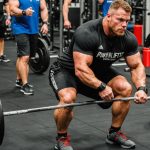Injury Prevention Overview
Understanding injury prevention in powerlifting is crucial for anyone serious about the sport. Powerlifting places significant demands on the body, making athletes prone to specific injuries. The significance of injury prevention strategies cannot be overstated, as they not only minimise the risk of injury but also contribute to performance longevity.
The nature of powerlifting means the lower back, shoulders, and knees are vulnerable zones. Implementing appropriate injury prevention strategies, such as targeted strength training and technique refinement, can safeguard these areas. An efficient program focuses on reinforcing weaknesses while promoting overall muscular balance.
Additional reading : Mastering High-Speed Bodyboarding: The Secrets to Precision and Control in Extreme Tricks
The connection between injury prevention and enhanced performance is evident. Athletes who prioritise injury prevention often experience an extended competitive lifecycle, allowing them to achieve greater milestones without disruption. The benefits of injury prevention go beyond immediate safety; they lay the foundation for sustainable progress and peak performance in the sport.
By placing importance on injury prevention, powerlifters can significantly improve their training outcomes. Safeguarding one’s health not only reduces setbacks but also ensures that the hours spent in the gym translate into gains on the competition platform. In essence, the conscientious incorporation of injury prevention is an investment in both present capability and future mastery of powerlifting.
Also to read : Transform Synchronized Swimming: Boosting Team Unity with Cutting-Edge Underwater Drills
Warm-Up Techniques
Incorporating effective warm-up routines before engaging in a powerlifting session is essential. A well-thought-out warm-up primes the body for exertion, ensuring it is adequately prepared to handle intense loads. The significance of proper warm-up routines cannot be overstated, as they are foundational in preventing injuries and ensuring longevity in lifting performance.
Recommended Dynamic Stretching Exercises
Dynamic stretching forms a pivotal part of effective warm-up exercises. Unlike static stretches, dynamic stretches involve movement, leading to an increase in blood flow, muscle temperature, and preps the nervous system. Key exercises include leg swings, arm circles, and bodyweight squats. These movements are designed to engage the muscle groups used in powerlifting, thus reducing the risk of injury.
Warm-up exercises such as these enhance joint mobility and flexibility, allowing for improved lifting performance. Moreover, executing a series of dynamic stretches before lifting has been linked to greater body awareness and control, both crucial for executing lifts with precision. This routine can further extend an athlete’s competitive life by negating the risk of sudden strains or tendon injuries while lifting.
Recovery Strategies
Incorporating effective recovery techniques into your training routine is vital for powerlifters aiming for peak performance. Proper recovery is integral to muscle recovery methods and minimising injury risks. An essential aspect of post-workout recovery includes active rest, which may involve activities like light stretching or yoga, helping to facilitate nutrient delivery to tired muscles while decreasing stiffness.
Post-workout recovery doesn’t stop at just physical rest; nutrition also plays a critical role. Consuming a balanced meal rich in proteins, healthy fats, and carbohydrates refuels muscles and accelerates recovery. Proper intake of nutrients helps repair muscle fibres torn during intense lifting sessions. Additionally, adequate hydration is crucial for maintaining muscle elasticity and cushioning joints. Dehydration can lead to cramps and reduce recovery efficiency, so it is essential to hydrate before, during, and after workouts.
Moreover, techniques like foam rolling and massages can target specific muscle groups to aid in faster recovery by enhancing blood circulation and reducing inflammation. Quality sleep is another pillar of recovery strategies, as it allows the body to produce growth hormones that repair and build muscular tissues. Incorporating these methods ensures comprehensive recovery and better overall performance.
Proper Form and Technique
Inculcating proper lifting technique is crucial for powerlifters aiming to minimise injury risk. Poor form often leads to unnecessary strain on muscles and joints, making it one of the main causes of injuries in powerlifting. Many lifters, unfortunately, bypass the foundational focus on form in pursuit of lifting heavier weights quickly.
To ensure safe lifting, athletes should emphasise maintaining a neutral spine, engaging core muscles, and utilising a full range of motion. Proper technique involves standing with feet shoulder-width apart, activating core stability, and lowering weights in a controlled manner. This reduces undue pressure on the lower back and knees, common stress points in powerlifting movements.
Technique coaching with a certified professional can substantially enhance safety and efficiency. Discerning coaches provide tailored advice, helping lifters correct biomechanical flaws that could lead to injuries. Additionally, receiving feedback from knowledgeable partners during training sessions can cement proper habits and adds a layer of safety.
Ultimately, understanding and mastering proper lifting technique not only ensures safety and performance longevity but also empowers athletes to push beyond previous limits safely. Through diligent focus, powerlifters cultivate stronger, injury-resilient bodies primed for exemplary performance.
Equipment Essentials
Powerlifting demands serious attention to powerlifting equipment for safety and performance. Using injury prevention gear is pivotal in maintaining athlete health throughout their careers. Essential equipment includes belts, knee sleeves, and wrist wraps, intended to provide stability and support during heavy lifts. A correctly fitted belt supports the lower back, helping maintain a stable core and reducing the risk of back injuries.
Supportive gear like knee sleeves and wrist wraps reinforces joint integrity and helps manage the strain experienced during squats and bench presses. These items compress the joints to keep them warm, enhancing proprioception and circulation. Their utilitarian nature in keeping joints properly aligned cannot be overlooked, as they work tirelessly to safeguard against potential strains.
The importance of properly fitting equipment lies in its effectiveness. A misfit can hinder movement or offer less protection, potentially defeating the gear’s purpose. Therefore, selecting the correct size and type is vital to ensure the equipment’s benefits are fully realised. Regular checks and adjustments are advisable as changes in muscle mass or body weight can impact fit and function, ensuring that safety remains a powerlifter’s top priority.
Flexibility and Mobility Training
Incorporating flexibility exercises and mobility training is pivotal for powerlifters aiming to ward off injuries and elevate their performance. Powerlifting isn’t just about strength; it demands a broad range of motion to perform lifts safely and effectively. By enhancing flexibility, athletes can alleviate muscle tightness and improve joint health—key elements in reducing injury risk.
Mobility training centres on ensuring joints move through their full spectrum while maintaining stability. Recommended routines might include dynamic stretches like leg swings, hip circles, and thoracic rotations, which encourage joint fluidity and muscle suppleness. Integrating these exercises regularly can diminish stiffness and promote better lifting technique.
Enhanced flexibility also contributes to superior form by allowing muscles to adapt to various positions essential for executing complex lifts. For powerlifters, the ability to execute squats and deadlifts without compromising posture is integral to preventing mishaps like strains or tears.
Practising targeted stretching and mobility routines reinforces the body’s capability to manage heavier weights without undue stress. Focusing on injury prevention through flexibility not only enhances athletic performance but supports longevity in the world of powerlifting. Trust in the process and reap the rewards of a resilient, flexible physique.
Common Mistakes to Avoid
Listening to your body is crucial in powerlifting. Ignoring pain or discomfort can lead to serious injuries, sidelining you from your workout routine. Mistakes in powerlifting often arise from pushing through strain or blindly chasing heavier loads without regard for safety. Understanding the body’s signals can help avoid injury-causing habits.
Frequent errors include improper warm-up routines or neglecting recovery strategies, both of which are instrumental in injury prevention. These oversights can compromise stability and muscle function, increasing the risk of tears and strains. Incorporating effective warm-up exercises and post-workout recovery methods are essential strategies that powerlifters should not overlook.
Maintaining proper lifting technique is another common area where mistakes occur. It’s important to focus on key elements such as a stable core and controlled movements to enhance lifting safety and prevent unnecessary stress on the body. Engaging with technique coaching can significantly rectify these issues, fostering better habits and lifting efficiency.
Prioritising safety in lifting involves developing a routine that allows for consistent monitoring of form and listening to the body. By addressing these injury-causing habits, powerlifters can effectively build a secure and productive workout regimen that champions both health and performance longevity.











